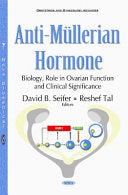Instant Download
Your unique download link appears right after you complete your purchase, and is also sent instantly to the email address you provided.

Couldn't load pickup availability
Your unique download link appears right after you complete your purchase, and is also sent instantly to the email address you provided.

9781634840125, 1634840127
David B. Seifer, Reshef Tal
Nova Science Publishers, Incorporated
May 1, 2015
387
This is the first book published that discusses state of the art research regarding AMH in human reproduction and medicine. This unique and vital protein impacts a variety of fundamental processes within the ovaries and testes. Since its discovery in 1947, every medical student has learned about the role AMH plays in embryonic sexual differentiation. However, the last fifteen years have witnessed AMH emerge from the bench to the bedside, from a scientific curiosity to a useful diagnostic tool with clinical utility and therapeutic applications. In female reproduction, AMH has undergone a virtual renaissance after it was discovered in the human ovarian follicle and later to reflect ovarian reserve. Since that time, much has been learned regarding the role of AMH in female reproductive aging and a number of other gynecological conditions. This is reflected by a number of peer-reviewed publications on AMH in human adult females, which has increased exponentially over the past three decades. It is only in the last decade that AMH has become an important marker of ovarian response, guiding clinical decision making in assisted reproductive technology (ART) as well as a useful aid in the diagnosis of polycystic ovarian syndrome (PCOS). In male reproduction, AMH has become a diagnostic tool in the complex evaluation of infants with intersex conditions, including ambiguous genitalia and cryptorchidism. The chapters of this book bring together experienced investigators with a variety of research interests in different aspects of AMH. Each contributor has conducted clinical, translational and/or basic research in the field of AMH. Each has an appreciation of what is known and an aspiration for solving what remains to be discovered. A better understanding of AMH pathophysiology may lead to the development of pharmacological treatments using AMH agonists and/or antagonists for a host of reproductive challenges. These include: the possible retardation of ovarian aging and menopause; a chemoprotectant for fertility preservation prior to chemotherapy; a tool to better control ovarian response to ART and/or to mitigate the deleterious effects of polycystic ovary syndrome; and a treatment for endometriosis, adenomyosis and/or endometrial and ovarian cancers. This book enables the reader to review the past, understand the present and consider the future of this multifaceted protein in the fields of reproductive medicine and gynecology.

